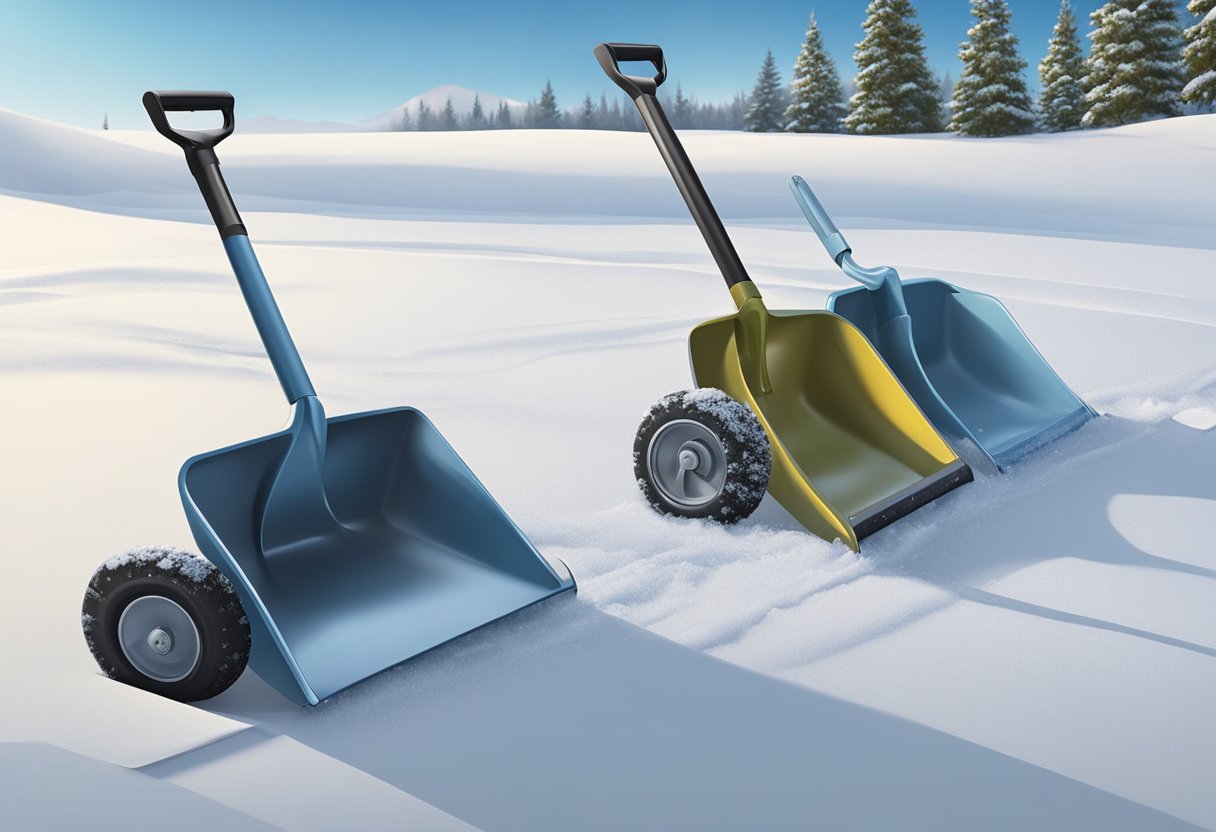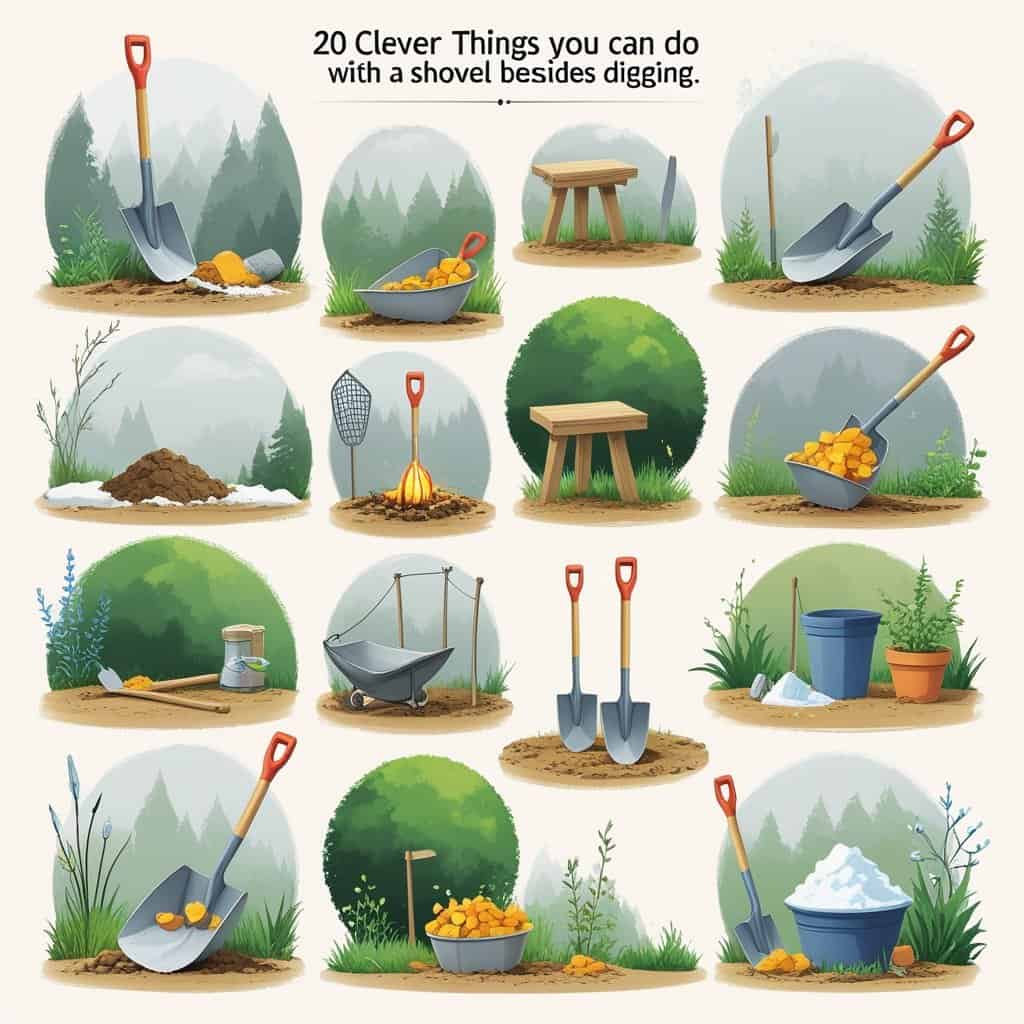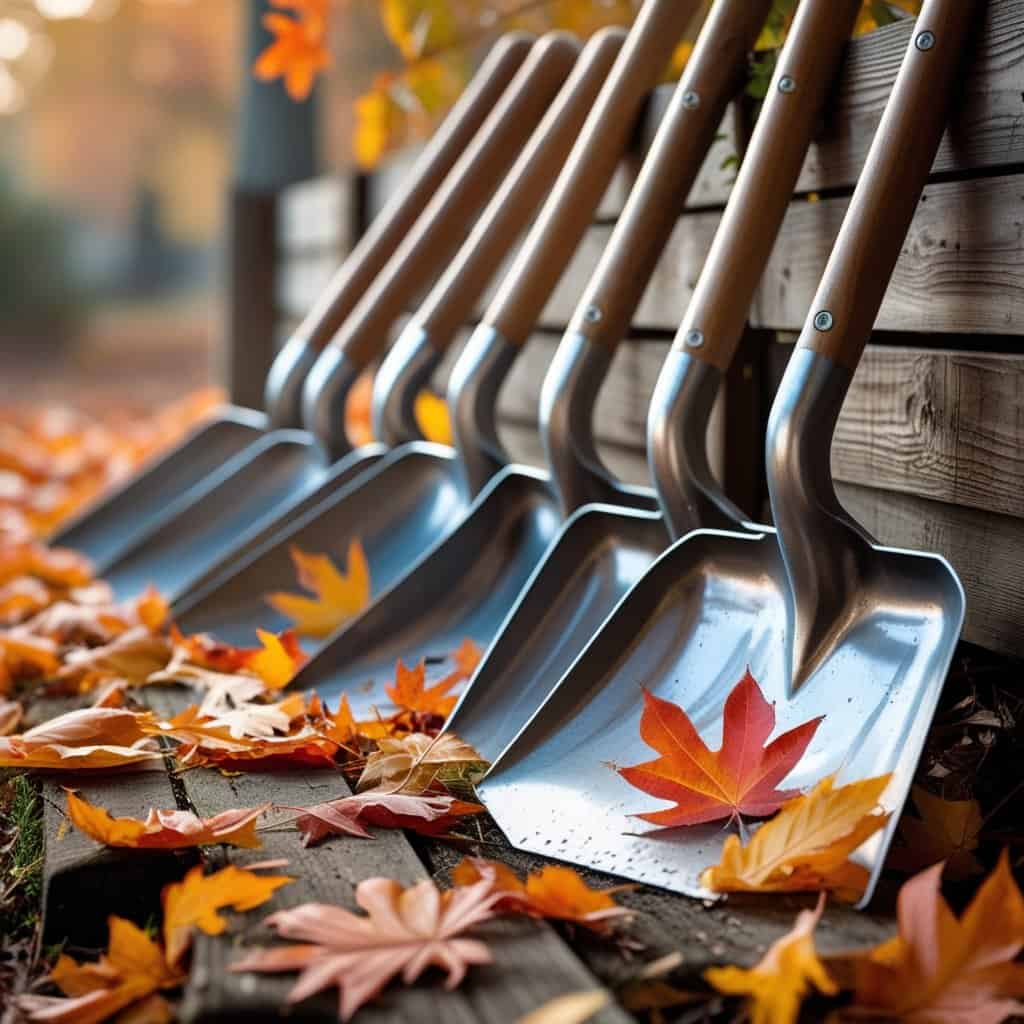As winter weather brings heavy snowfall, clearing driveways and sidewalks becomes a priority for many. In recent years, snow shovels with wheels have gained popularity as a way to reduce the effort needed to move snow. These tools leverage the addition of wheels to improve maneuverability, potentially lessening physical fatigue and increasing efficiency.
Table of Contents
Snow Shovel With Wheels Design
The design of a wheeled snow shovel plays a critical role in its performance. The right balance between the shovel’s blade size, handle design, and wheel placement can significantly affect how easily the snow can be moved. Equally important are the materials used in construction, which must withstand cold temperatures and repetitive use. Furthermore, the type of snow, whether light and powdery or wet and heavy, can impact the shovel’s effectiveness, and varied designs cater to these conditions.
Designing snow shovels with wheels is an innovative approach to enhance maneuverability when considering snow removal. Adding wheels reduces the physical strain associated with snow clearing by allowing users to push or pull the shovel with less effort than lifting heavy loads.
Its design elements include adjustable handles to suit various user heights, lightweight and durable blade materials that can handle heavy snow while minimizing user fatigue, and strategically placed wheels that provide balance and easy movement over different snow conditions. The wheeled design improves the shovel’s ability to move snow without lifting, which increases efficiency.
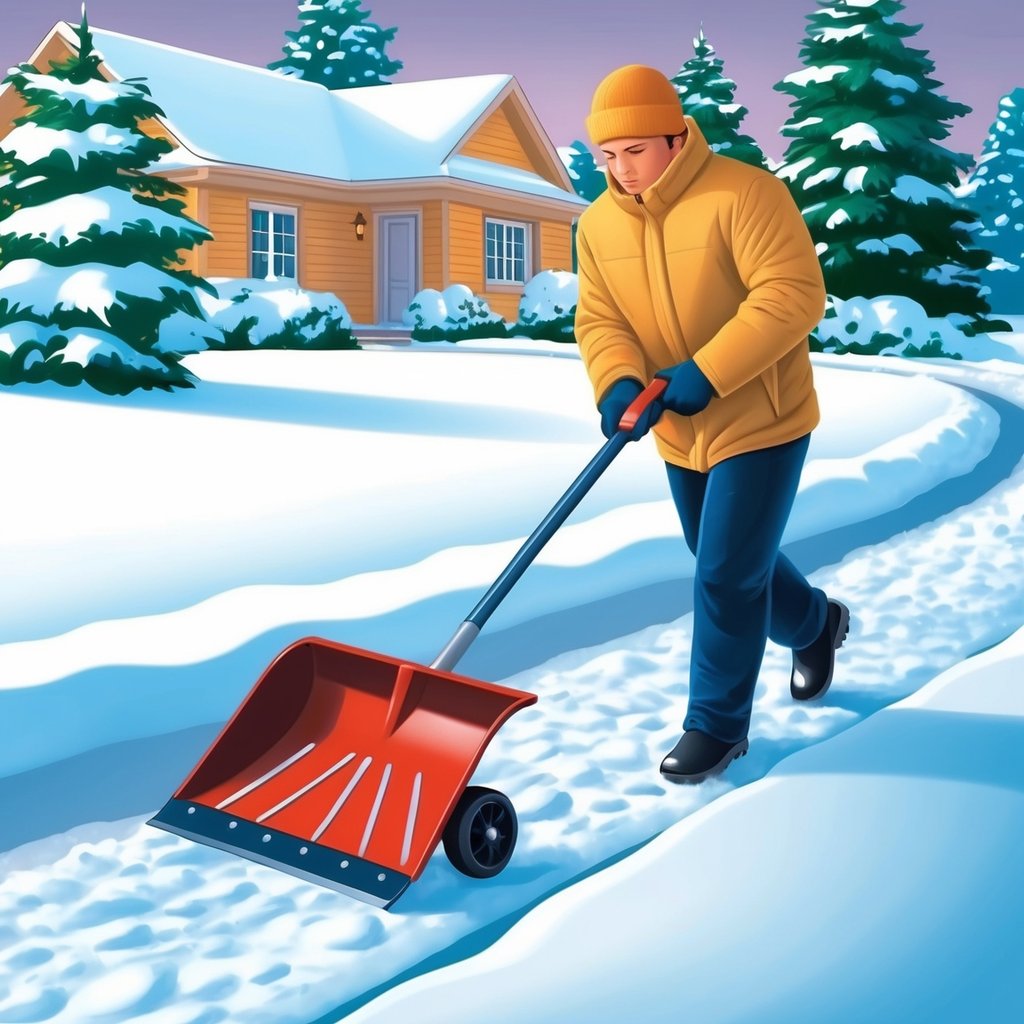
Biomechanics of Snow Shoveling
When we consider the biomechanics of snow shovelling, we’re looking at how our bodies move and handle the physical stress of the activity. Snow shovelling without wheels demands significant effort from various muscle groups. Here is an understanding of the mechanics involved:
- Upper Body: Utilizes the deltoids, latissimus dorsi, biceps, and triceps.
- Core: Engages the rectus abdominis, obliques, and erector spinae.
- Lower Body: Employs the quadriceps, hamstrings, gluteus maximus, and calves.
Movement Dynamics:
- Lifting: Bending at the hips and knees to scoop the snow.
- Twisting: Rotational movement of the spine to offload the snow.
- Throwing: A combination of arm, back, and leg power to propel the snow.
Using a snow shovel with wheels, we aim to reduce the load on our muscles and spine. Wheels facilitate forward movement with less physical exertion. The design of wheeled shovels often includes adjustable handles to maintain a more upright posture, which minimizes bending and reduces lower back strain.
Energy Expenditure:
- Traditional Shoveling: High energy and strength requirement due to lifting and throwing motions.
- Wheeled Shoveling: Lower energy is needed, as wheels assist in moving the snow with less lifting.
By understanding the biomechanics involved, we optimize our approach to snow shovelling, focusing on ergonomics and efficiency. Wheeled shovels offer a design that aligns with our biomechanical considerations, potentially reducing the risk of injury and fatigue.
Comparative Analysis of Maneuverability
Several vital factors greatly influence maneuverability when we examine snow shovels with wheels. To provide a clear comparison, let’s outline these in a readily accessible format.
- Wheel Size: Shovels with larger wheels can easily navigate deep snow.
- Wheel Diameter Ease of Maneuver: Small wheels are less maneuverable on uneven terrain; large wheels are more maneuverable on a variety of surfaces
- Handle Design: Ergonomic handles reduce the effort needed to pivot and turn.
- Handle Type & Maneuverability Impact: Straight handlesgive you the ability to move up and back whereas curved handles enhance leverage and control
- Shovel Weight: Heavier models require more force to steer, while lighter shovels can be less stable.
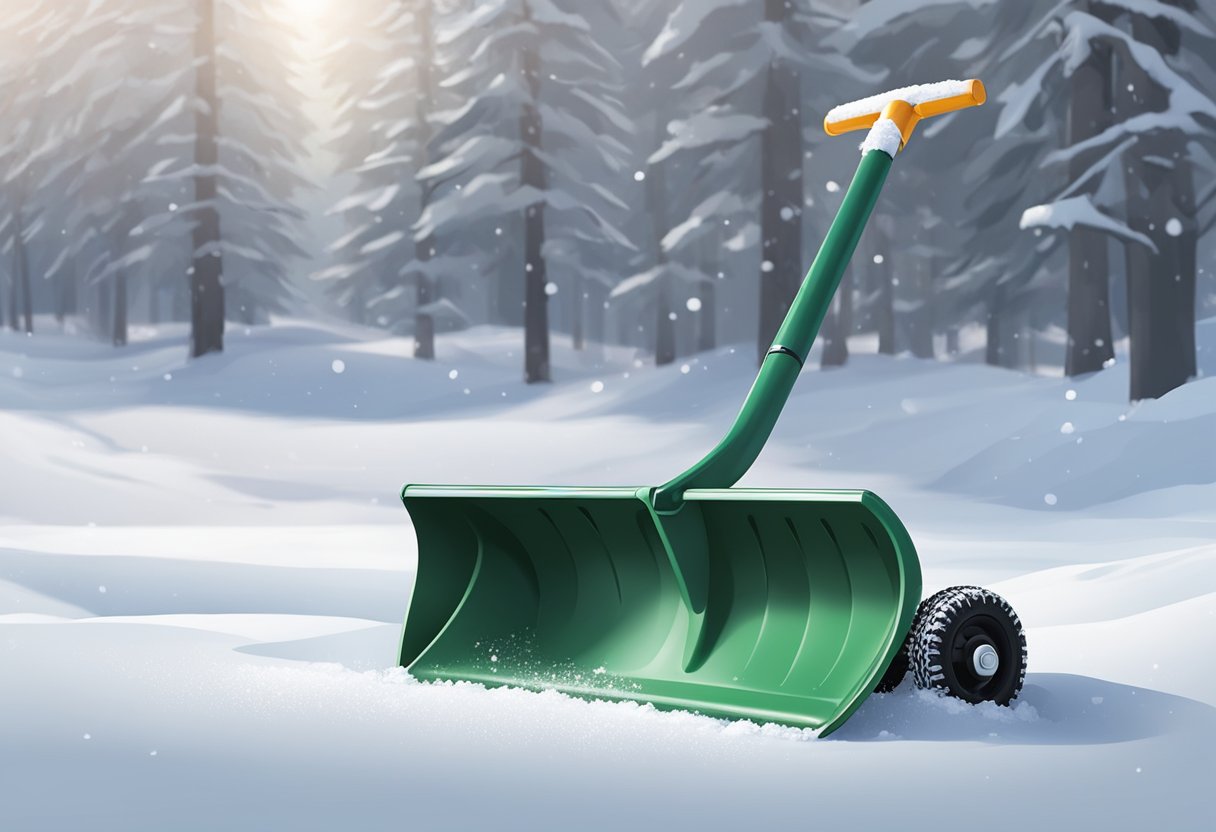
Wheel Design and Traction Control
The design of the wheels is crucial to the maneuverability of a snow shovel with wheels. Aim for wheels large enough to roll over snow and slush easily. Typically, a diameter of at least 6 inches proves most effective.
The wheels material affects both durability and traction. Plastic wheels may not provide enough grip, so we prefer rubberized or air-filled tires that can compress and adapt to the surface for improved traction.
TABLE 1
| Wheel Material | Benefits | Potential Downsides |
|---|---|---|
| Plastic | Lightweight, Cost-effective | Poor traction, Less durable |
| Rubberized | Better traction, Durable | Heavier, May be more expensive |
| Air-filled | Excellent traction, Shock absorption | Requires maintenance, Risks of puncture |
Tread patterns are another aspect we examine. Deep treads and grooves allow for better grip on icy surfaces, reducing the chance of slippage. For enhanced control, we suggest you opt for a wide wheelbase. The spread of wheels supports stability in heavy snow. Also consider adjustable wheels: The ability to change the height and angle accommodates different snow conditions.
For traction control, incorporate features like:
- Metal cleats: These can dig into ice to offer more resistance.
- Locking mechanisms allow the wheels to lock in place for challenging tasks, like chipping away at ice.
Ergonomics and User Comfort
When examining the ergonomics of snow shovels with wheels, consider the design aspects that affect the user’s physical comfort and efficiency. Proper ergonomic design minimizes the strain on the body while maximizing the shovel’s functionality; by incorporating these ergonomic features, snow shovels with wheels create a more user-friendly snow removal experience.
Adjustable Handles:
Most wheel-assisted snow shovels come with adjustable handle heights, allowing us to set the handle to a height that prevents us from bending too low, reducing back strain.
- Ideal handle height: varies per individual
- Adjustment mechanism: typically a pin or a twist-and-lock feature
Handle Design:
The shape of the handle also contributes to comfort. An ergonomic grip that suits the natural position of our hands will reduce the potential for blisters and fatigue.
- Standard shapes: D-grip, ergonomic bar
- Materials: often rubberized for grip and insulation
Leverage and Angle:
The angle of the handle about the shovel blade impacts how effectively we leverage our body weight. A well-angled handle allows us to push snow more efficiently without unnecessary bending.
- Optimal angle: varies; look for slightly inclined from the vertical axis
- Benefit: improved force application, reduced effort
Wheel Placement and Size:
Wheels are critical to maneuverability and user comfort. Their placement and size can significantly affect the workload on our bodies. Properly positioned wheels distribute the weight of the snow, making it easier for us to push without lifting.
- Preferred wheel placement: near the back of the blade
- Wheel Diameter: more significant for easier rolling over uneven surfaces
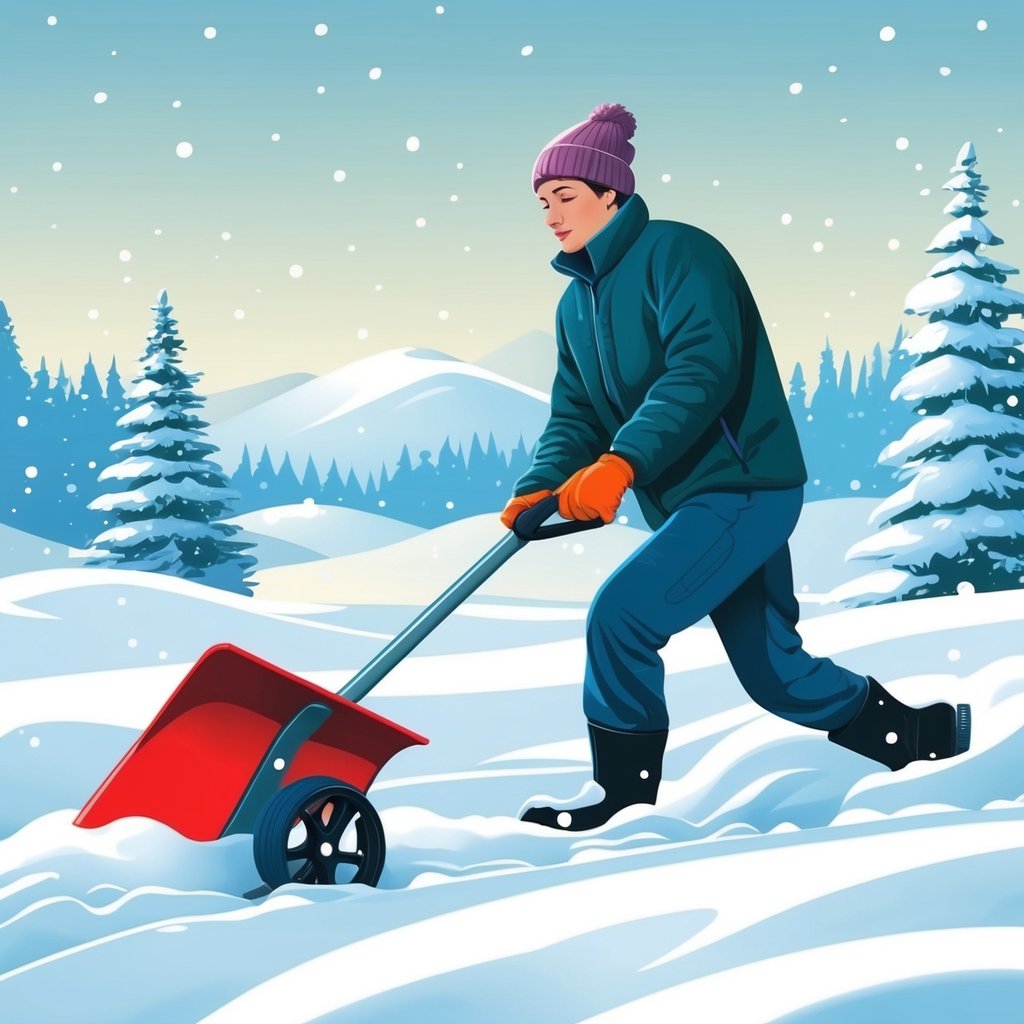
Materials and Construction
Materials for snow shovels with wheel frames are best constructed from lightweight metals such as aluminum for strength-to-weight ratio. Occasionally, you will find snow shovels with wheels made from high-impact plastic for additional weight reduction.
The blades of these shovels are often made from polyethylene or metal. We choose polyethylene for its flexibility, which resists cracking in sub-zero temperatures or galvanized steel to resist rusting and wear when opting for metal.
Utilizing stainless steel bolts and fasteners prevents corrosion and ensures longevity. The connection points will ideally be reinforced to withstand the repetitive motion and pressure of shovelling.
Snow Types and Shovel Performance
When examining how snow shovels with wheels perform, consider the type of snow you are dealing with. Different snow conditions can significantly affect the shovels maneuverability and efficiency. We classify snow as light, fluffy, wet, heavy, and icy or compacted.
Light and Fluffy Snow
- Easier to move
- Less traction needed
- Wheels glide smoothly
Our experience shows that wheel-equipped shovels can move large volumes of light and fluffy snow without much effort. The wheels don’t sink and allow for unhindered movement.
Wet and Heavy Snow
- Requires more force
- Wheels may sink or clog
- Greater physical exertion
Shoveling wet and heavy snow poses more challenges. We often need more force, and our wheels may require a deeper tread to prevent slipping. Wet snow can also accumulate around the wheels, necessitating frequent clearing to maintain performance.
Icy or Compacted Snow
- Challenging for wheels
- May need ice-breaking capabilities
- Shovel design is critical
When tackling icy or compacted snow, wheels can struggle to maintain grip, and the shovel blade needs to be strong enough to chip through the ice. In our experience, adding metal edges on the shovel blade aids in breaking through tough layers.
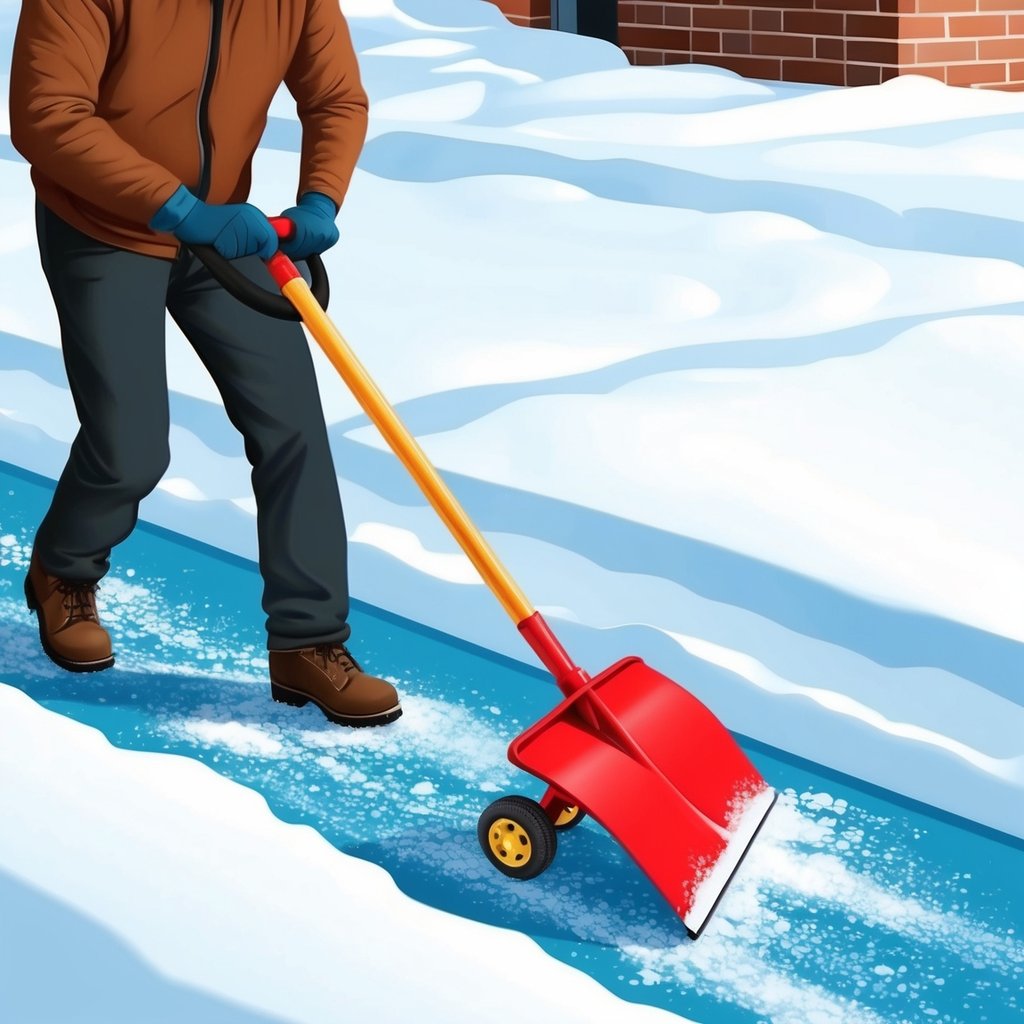
Market Trends For Wheeled Snow Shovels
In recent years, there has been a significant growth in the popularity of wheeled snow shovels. The market has responded positively to their convenience and ease of use. Customers increasingly seek ergonomic solutions to snow removal, and wheeled shovels effectively meet this demand. Snow shovels with wheels generally range from $50 to $150, depending on features and build quality.
FINAL THOUGHTS
While the initial investment for a snow shovel with wheels may be higher than a traditional shovel, the long-term benefits, including reduced physical effort and potentially lower health-related expenses, should be considered when making a purchase decision. As winter weather continues to challenge homeowners, the growing popularity of wheeled snow shovels underscores the importance of innovation in addressing practical needs during the snowy months.
How effective are wheeled snow shovels in heavy snowfall?
Wheeled snow shovels are highly effective in moderate snowfall but may face wet, heavy snow challenges. Their design allows more effortless movement, but snow’s weight and consistency can affect performance.
Can wheeled snow shovels be easily used by individuals of all strengths?
Wheeled snow shovels are designed to reduce the effort required to clear snow, making them suitable for people of various strength levels. They can be particularly beneficial for those with limited physical strength.
What features should one look for in a snow shovel with wheels to ensure easy maneuverability?
Look for adjustable handle heights, sturdy wheels capable of handling rough terrain, and a lightweight frame. Ergonomic design and easy turning capability are also critical factors for maneuverability.
How does the design of a snow shovel with wheels impact its plowing capability?
The design, including blade shape, wheel placement, and handle design, directly affects plowing capability by influencing the shovel’s balance, leverage, and effort required to move snow efficiently.

